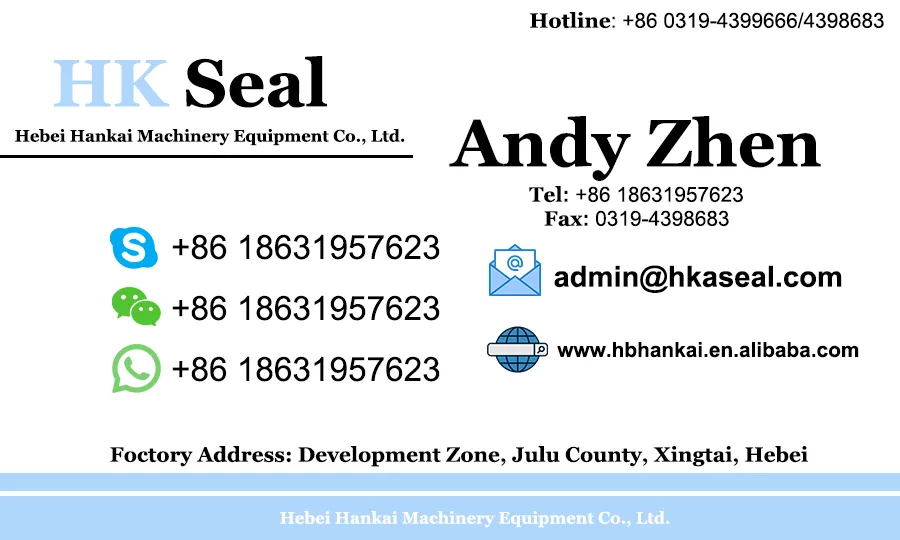Dec . 21, 2024 21:48 Back to list
hydraulic shaft seal
Understanding Hydraulic Shaft Seals Essential Components in Fluid Power Systems
Hydraulic systems are integral to a wide range of industrial applications, from manufacturing machinery to agricultural equipment. At the heart of these systems lies an essential component known as the hydraulic shaft seal. While often overlooked, hydraulic shaft seals play a critical role in ensuring the efficiency and longevity of hydraulic equipment. This article delves into the significance of hydraulic shaft seals, their types, applications, and maintenance.
What is a Hydraulic Shaft Seal?
A hydraulic shaft seal is a device used to prevent fluid leakage from a hydraulic cylinder or pump. It seals the gap between the rotating shaft and the static housing, thereby keeping hydraulic fluid contained within the system while preventing contaminants from entering. Without effective sealing, hydraulic systems can suffer from reduced efficiency, increased wear, and potential system failure.
Types of Hydraulic Shaft Seals
Hydraulic shaft seals come in various designs and materials, tailored to meet specific operational requirements. The most common types include
1. Rotary Seals These seals are designed to seal around rotating shafts. They typically consist of a flexible lip that presses against the shaft, creating a sealing effect. Rotary seals are commonly used in hydraulic motors and pumps.
2. V-Rings These seals are made from elastomeric materials and provide a versatile sealing solution. V-rings can accommodate misalignment and are often used in environments with light to moderate contamination.
3. Composite Seals Combining different materials, composite seals offer enhanced durability and resistance to extremes in temperature and chemical exposure. They are ideal for demanding hydraulic applications.
4. Lip Seals Lip seals feature a projecting lip that contacts the shaft. They are particularly effective at keeping lubricants in and contaminants out, making them popular in hydraulic applications.
5. O-Rings Commonly used due to their simplicity, O-rings can serve various sealing applications. However, they are not ideal for high-pressure or high-speed applications due to temperature and pressure limitations.
Applications of Hydraulic Shaft Seals
Hydraulic shaft seals are utilized across numerous industries, including
hydraulic shaft seal

- Manufacturing In machines like hydraulic presses and assembly systems, these seals help maintain fluid integrity, enabling smooth operation
.- Agriculture Hydraulic systems in tractors and harvesters rely on seals to ensure that operations like lifting and steering are efficient without leaks.
- Construction Heavy machinery, such as excavators and lifts, depend on reliable hydraulic shaft seals for safety and performance.
- Automotive In vehicles with hydraulic braking and steering systems, effective sealing is critical for safety and performance.
Importance of Proper Maintenance
Maintaining hydraulic shaft seals is vital for the overall efficiency of hydraulic systems. Regular inspections can identify wear and damage early, preventing leaks that could lead to downtime or costly repairs. Key maintenance practices include
1. Regular Inspection Check seals for signs of wear, cracks, or deformation regularly. Early detection can mitigate major failures.
2. Fluid Quality Ensure that the hydraulic fluid used is clean and suitable for the application. Contaminants in the fluid can degrade seal materials, leading to premature failure.
3. Alignment Checks Misalignment between the shaft and the sealing surface can lead to increased wear on the seals. Regular alignment checks can prevent this issue.
4. Temperature Monitoring Extreme temperatures can affect seal performance. Monitoring the temperature of the hydraulic system can help prevent overheating and potential seal failure.
5. Replacement Planning Establish a replacement schedule for seals based on manufacturer recommendations and historical performance data. This proactive approach can enhance system reliability.
Conclusion
Hydraulic shaft seals are pivotal components in hydraulic systems, ensuring fluid retention and preventing contamination. Understanding their types, applications, and maintenance requirements can significantly enhance the performance and lifespan of hydraulic machinery. As industries continue to rely on hydraulic systems for efficiency and productivity, the importance of effective sealing solutions becomes increasingly clear. Proper care and attention to hydraulic shaft seals can lead to optimized machinery performance, reduced operational costs, and extended service life of equipment. Thus, investing in quality seals and diligent maintenance practices should be a priority for any operation that employs hydraulic technology.
-
Unlocking the Potential of Hydraulic Systems with Essential Sealing Solutions
NewsAug.06,2025
-
Unleash the Power of Your Hydraulic Systems with Our Premium Seal Kits
NewsAug.06,2025
-
Specialized Hydraulic Seal Kits for Breakers, Pistons, and Presses
NewsAug.06,2025
-
Revitalize Hydraulic Systems with Premium Repair and Seal Kits
NewsAug.06,2025
-
Fortify Your Cylinders with Premium Sealing Solutions
NewsAug.06,2025
-
Elevate Hydraulic System Reliability with Specialized Seal Kits
NewsAug.06,2025
-
TCN Oil Seal Metal Ring Reinforcement for Heavy Machinery
NewsJul.25,2025
Products categories
















